Media
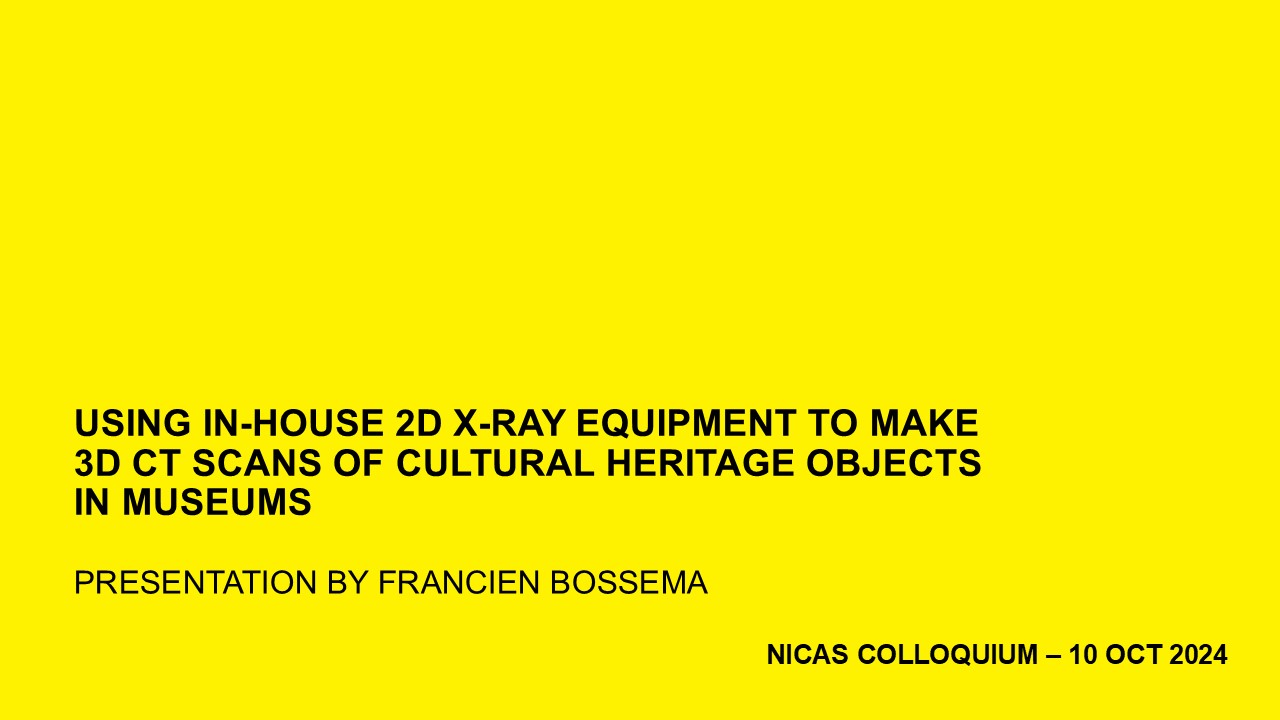
NICAS Colloquium
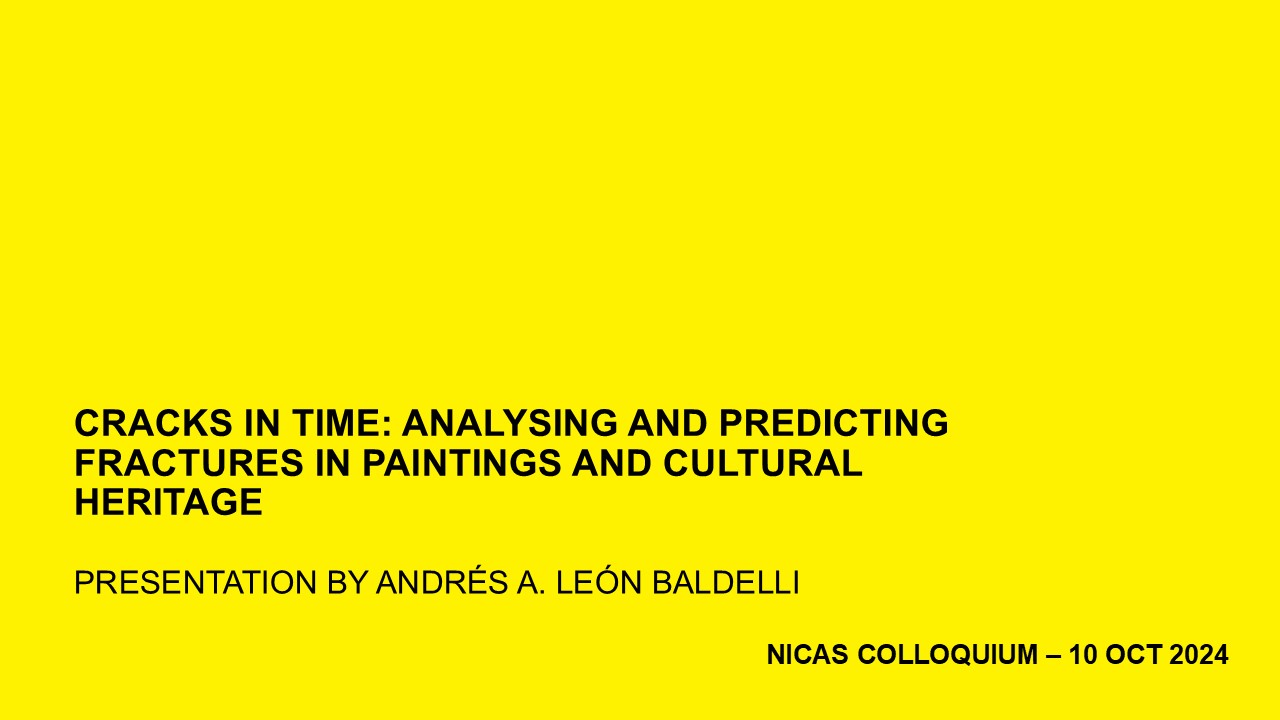
NICAS Colloquium
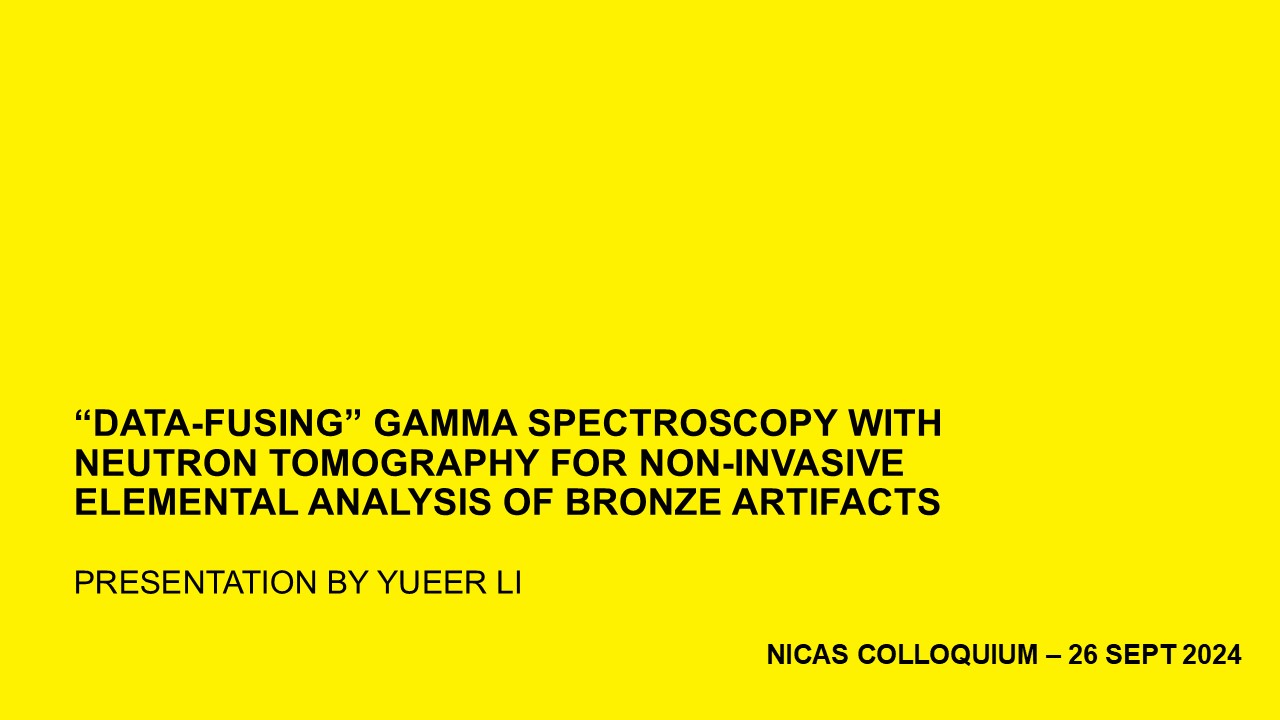
NICAS Colloquium
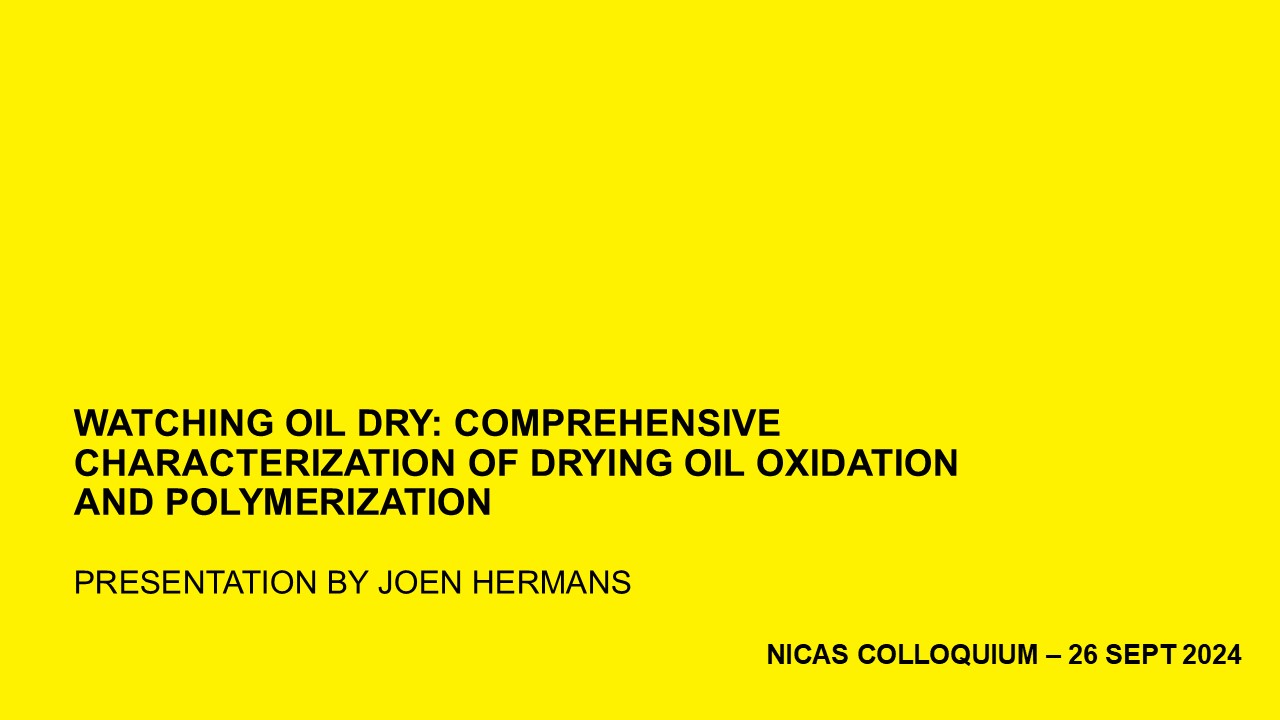
NICAS Colloquium
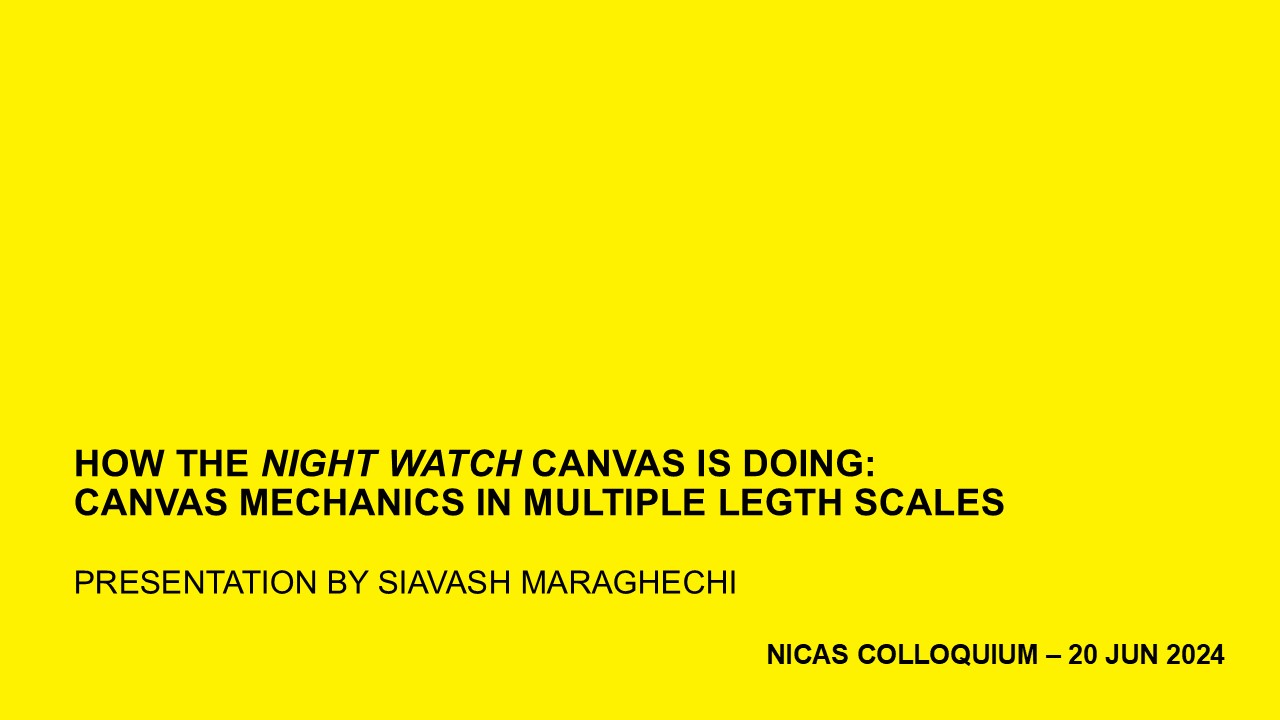
NICAS Colloquium
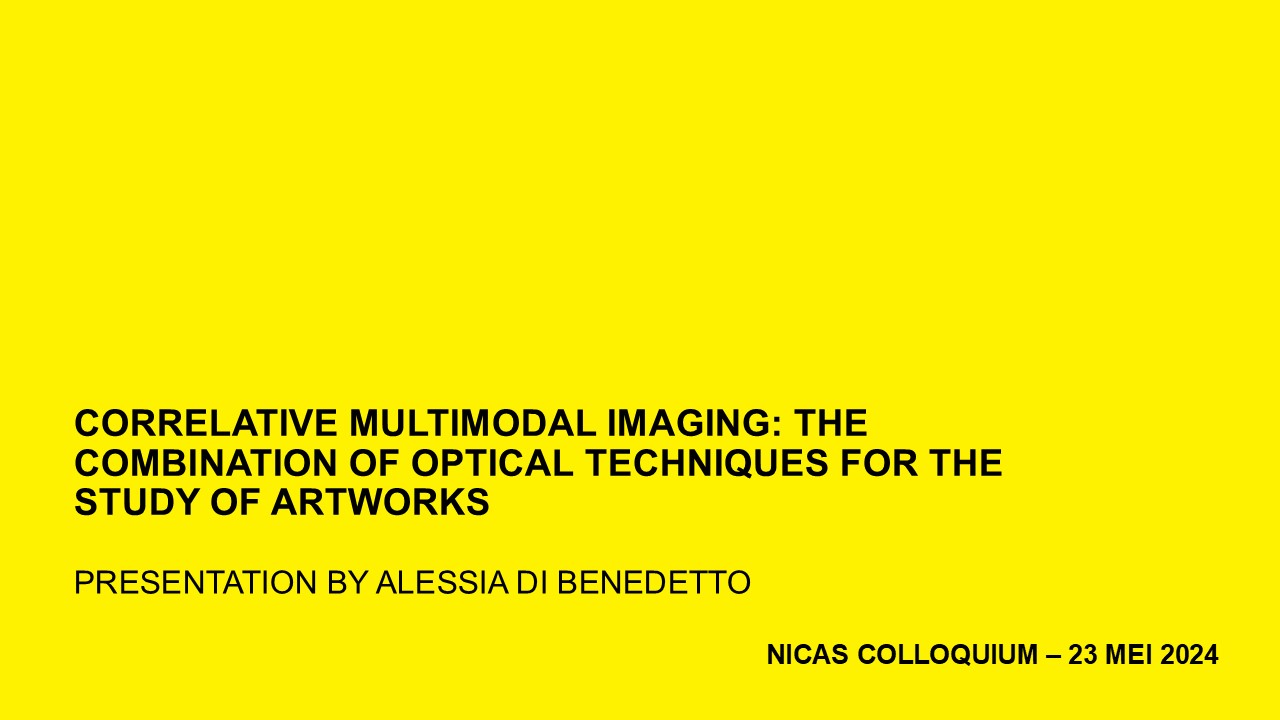
NICAS Colloquium
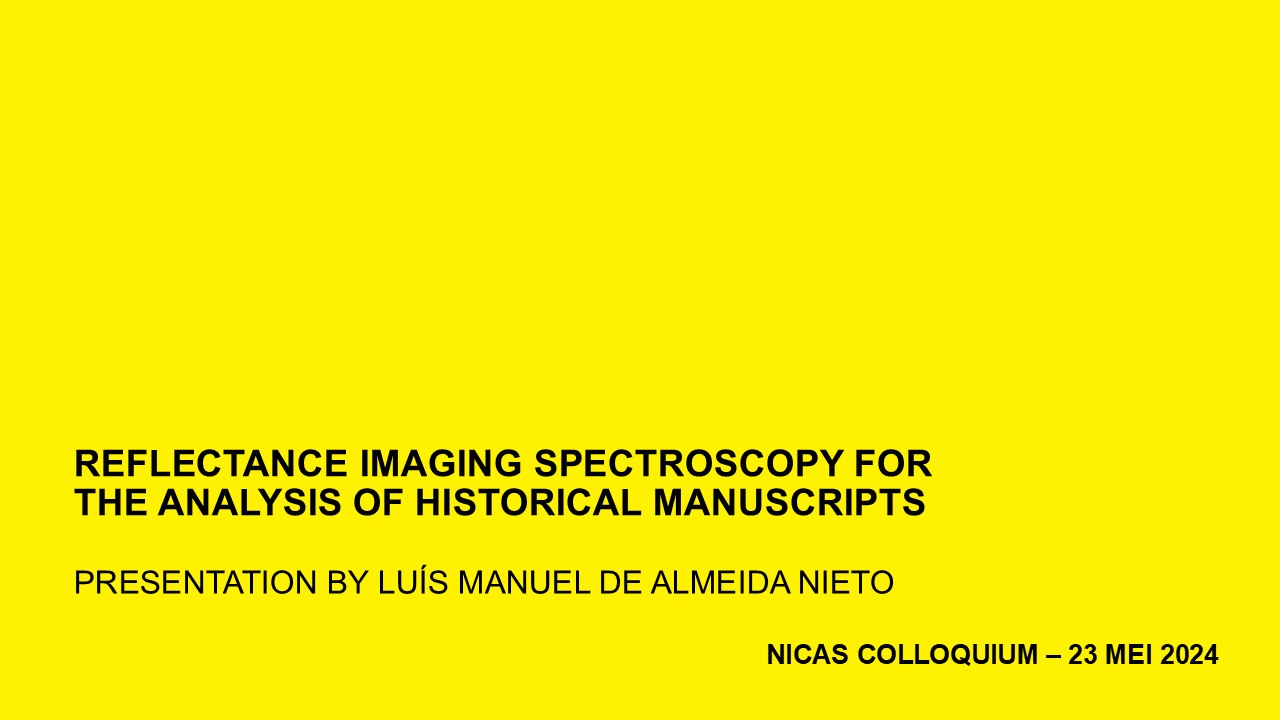
NICAS Colloquium
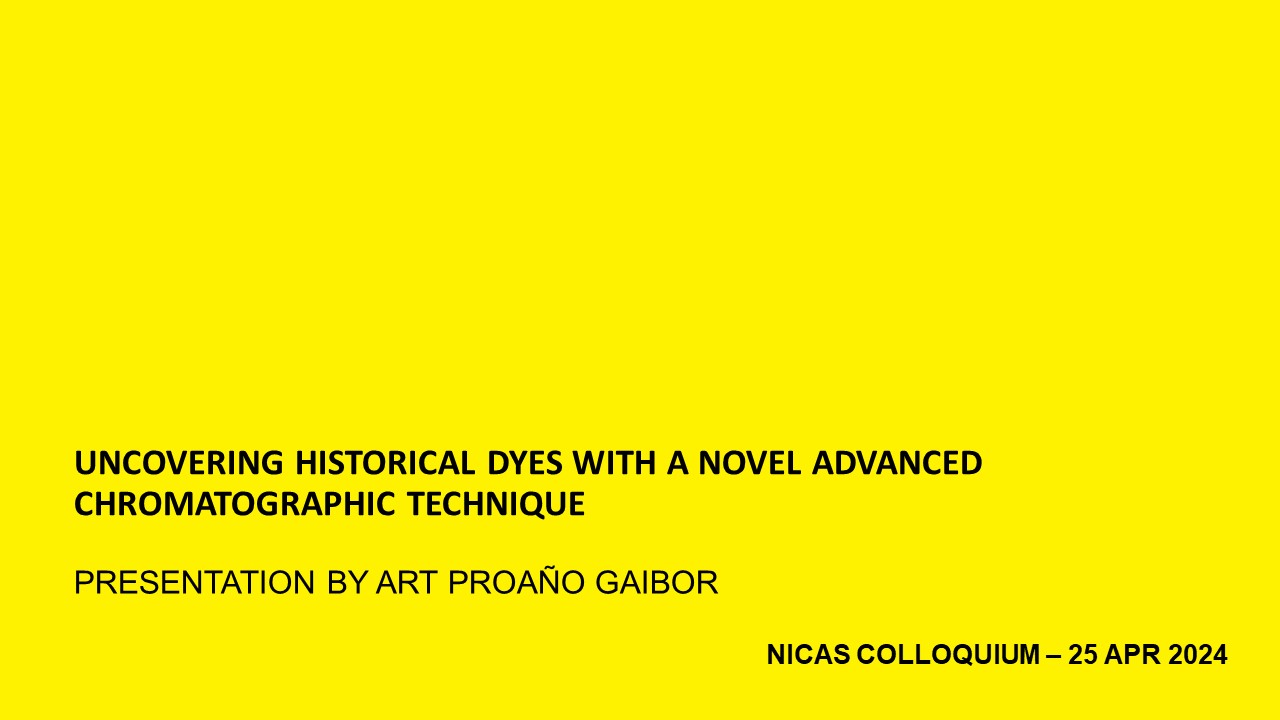
NICAS Colloquium
-
NICAS Colloquium
► Francien Bossema – Using in-house 2D X-ray equipment to make 3D CT scans of cultural heritage objects in museums. Abstract: A powerful technique for exposing the interior of museum objects is computed tomography (CT). However, the lack of affordable and versatile CT equipment in museums, combined with the challenge of transporting precious collection objects, currently keeps this technique out of reach for most cultural heritage applications. We propose an approach for creating accurate CT reconstructions using only standard 2D radiography equipment already available in most larger museums. Specifically, we demonstrate that a combination of basic X-ray imaging equipment, a tailored marker-based image acquisition protocol, and sophisticated data-processing algorithms, can achieve 3D imaging of collection objects without the need for a costly CT imaging system. We implemented this approach in the British Museum (London), the J. Paul Getty Museum (Los Angeles), and the Rijksmuseum (Amsterdam). Our work paves the way for broad facilitation and adoption of CT technology across museums worldwide and was recently published in Nature Communications. Bio: Francien Bossema obtained her master’s degree in Mathematics, with an additional specialisation in Science Communication & Society from Leiden University, The Netherlands. In 2024 she obtained her Ph.D. degree at the national research institute for mathematics and computer science (CWI) in Amsterdam, The Netherlands, in collaboration with the Rijksmuseum, Amsterdam, on the topic of ‘Tailoring X-ray tomography techniques for cultural heritage research’. Part of her research was performed at the British Museum (London, UK). During her Ph.D. she published four peer-reviewed first author articles, amongst others in Scientific Reports and Nature Communications. She is currently engaged as postdoctoral fellow at the Rijksmuseum, Amsterdam and as postdoctoral researcher at the Centrum Wiskunde & Informatica. Last summer, she was at the J. Paul Getty Museum in Los Angeles, USA, for a Museum Guest Scholarship. More information, such as a list of publications, presentations, blogs and videos, can be found here: fgbossema.github.io. -
NICAS Colloquium
► Andrés A. León Baldelli– Cracks in Time: Analysing and Predicting Fractures in Paintings and Cultural Heritage Abstract: Cracks and fractures in paintings and other elements of our cultural heritage are transitional phenomena that significantly impact the stability and longevity of these artworks. These processes, driven by complex interactions of environmental and material factors, raise fundamental theoretical questions and have practical implications for the preservation and understanding of the artistic and historical legacy. I will share some theoretical insights on the modeling and analysis of these irreversible natural phenomena in the context of thin film fracture, introducing an intuitive energetic perspective on the formation and propagation of cracks which emphasises a key intuitive notion of observability for evolutionary processes. Some recently solved numerical problems illustrate the point. How can these tools be integrated with models, high-resolution imagery, and the many in situ observation data and empirical studies? I invite a discussion and collaboration in the modeling and simulation of crack phenomena in artworks, with the goal of developing a robust platform capable of simulating and predicting the formation and progression of cracks, as well as supporting conservation efforts. This platform aims to provide art historians, curators, and conservation specialists with a predictive tool for anticipating and monitoring damage in paintings, further enhancing our fundamental understanding of how matter responds to changing environmental conditions. By presenting these models, approaches, and data sources, I hope to stimulate collaboration within the heritage and conservation community to refine and validate our methodologies. Bio: Andrés León Baldelli is a CNRS researcher at the ∂’Alembert Institute in Paris, specialising in theoretical mechanics and applied mathematics. He holds an MSc from La Sapienza University and a PhD from Sorbonne Université [2]. Current research topics concern evolutionary systems, energy-driven pattern formation, variational methods, and singular perturbations. A recent contribution has focused on a numerical code for simulating fracture processes in brittle structures [3], enabling the study of arbitrarily complex crack patterns in diverse materials and geometries. References [1] Groisman, A and Kaplan, E. “An experimental study of cracking induced by desiccation.” Europhysics Letters, vol. 25, no. 6, 1994, pp. 415-420. [2] León Baldelli, Andrés A. On Fracture of Thin Films: a Variational Approach. PhD thesis, Université Pierre et Marie Curie-Paris VI, 2013. [3] León Baldelli, Andrés A. and Cesana, Pierluigi. Variational Solvers for Irreversible Evolutionary Systems. arXiv preprint arXiv:2404.08356, 2024 -
NICAS Colloquium
Yueer Li – “data-fusing” gamma spectroscopy with neutron tomography for non-invasive elemental analysis of bronze artifacts Abstract: A significant challenge in researching bronze artefacts is determining their elemental composition non-invasively. The most common technique used in museums, XRF, only detects signal from surface due to its limited penetration depth. Unlike X-rays, neutrons can penetrate bulk metals, making neutron-based methods the only possible approach to non-destructively access the interior of metal sculptures. Neutron tomography (NT) exploits this capability to reveal structures and is increasingly popular in bronze research, but the unavoidable gamma radiation induced by neutrons is traditionally seen as a drawback. However, this temporary radiation contains valuable elemental information that can be extracted “for free”. Based on this, I developed a ray-tracing simulation based method that combines gamma spectroscopy (GS) with NT, enabling both geometry and elemental composition of the interior of bronzes to be determined from a single NT experiment. In this presentation I will show the concept behind the data fusion and how it allows to obtain quantitative elemental information from two semi-quantitative experimental techniques. Bio: Yueer Li is a fourth-year PhD candidate in the Neutron & Positron Methods for Materials group (NPM2) of Delft University of Technology (TU Delft) under the supervision of Dr. Lambert van Eijck. She is involved in the NICAS “Beeldvorming” project, which focuses on developing neutron-based approach to look inside cultural heritage objects in a non-invasive manner. -
NICAS Colloquium
Joen Hermans – Watching oil dry: Comprehensive characterization of drying oil oxidation and polymerization Abstract: Many issues in the conservation of oil paint lead towards a very challenging central question: what is the molecular structure of an aged oil binder? In this context, it is important to understand how factors like paint composition and curing conditions affect the chemistry and network structure of the oil binder, and subsequently the links between the structure and long-term paint stability. In our journey to answer these questions, we employed time-resolved ATR-FTIR spectroscopy and comprehensive data analysis to study the curing behavior of five types of drying oil and the effects of curing temperature as well as the presence of a curing catalyst (PbO). This approach yielded a very detailed insight into the changing chemistry of oils during drying. Analysis of reaction rates suggested that PbO induces a network structure with a more heterogeneous cross-link density, and the ATR-FTIR spectra indicate lower levels of oxidation in those cases. Finally, lower temperatures appear to favor the formation of more carboxylic acid groups in oil mixtures with PbO. Bio: Joen Hermans is Assistant Professor Conservation Science, a joint position between the Conservation & Restoration program and the Van ‘t Hoff Institute for Molecular Sciences, both at the University of Amsterdam. Since 2017, he has held an additional position as researcher at the Conservation & Science department of the Rijksmuseum. He obtained his PhD on metal soap formation in oil paint under supervision of Piet Iedema and Katrien Keune at the University of Amsterdam in 2017. Between 2018-2022, he worked on a NWO/Veni project studying the influence of water on oil paint chemistry. -
NICAS Colloquium
Siavash Maraghechi – How the Night Watch canvas is doing: Canvas mechanics in multiple length scales. Abstract: The structural integrity of the canvas of the Night Watch is an essential factor regarding the safety of the loads applied to the painting by the new spring-tensioning system and the long-term stability of the canvas in terms of degradation. Careful inspection of the original canvas of the painting indicates a highly degraded and brittle state, leaving the lining canvas applied in 1975 as the main load-bearing part of the canvas system. The mechanical properties (Young’s modulus, strength, and strain at fracture) of the lining canvas of the Night Watch are experimentally assessed at three length scales, i.e., fibre, thread, and canvas. Dedicated methodologies based on in-situ micro-tensile testing are chosen or developed for each scale. By fitting a simple mathematical function to the experimental data, scaling laws are established for Young’s modulus and strength of the lining canvas of the Night Watch. These scaling laws can be used in the future to monitor the degradation extent of the lining canvas, based on a minimum number of non-invasive tests on individual fibres. Moreover, comparing the mechanical properties of the lining canvas with a similar canvas kept in less aggressive conditions at Rijksmuseum in Amsterdam sheds light on the current state of degradation of the lining canvas of the Night Watch. Bio: Siavash Maraghechi is a post-doctoral researcher at Eindhoven University of Technology (TU/e). He obtained his PhD in the mechanical engineering department in TU/e where he focused on microscopy techniques and full field methods for deformation measurements in complex materials. He entered the world of conservation science through a chemo-mechanical study of degradation of paper, where he developed a technique for accurate micro-mechanical testing of cellulose fibres, applicable to other materials such as canvas. Currently he is involved in a project concerning chemo-mechanical degradation of oil paints. -
NICAS Colloquium
Alessia Di Benedetto - Correlative Multimodal Imaging: the combination of optical techniques for the study of artworks Abstract: Direct Correlative Multimodal Imaging is an emerging approach that integrates multiple imaging modalities in a hybrid setup, providing a comprehensive understating of a sample. Such an approach would be extremely interesting in Heritage Science, where artworks exhibit high material heterogeneity. In this field, while the necessity of a multi-analytical approach is acknowledged, current methods often employ separate setups sequentially. Instead, the combination of different non-destructive optical techniques in a unique setup enables precise alignment of datasets, yielding complementary information. This presentation introduces two such setups: a Raman-Photoluminescence microscope and a multiscalar camera for reflectance and photoluminescence measurements. Their description is complemented with a specialized multimodal analysis protocol, facilitating insightful information extraction from collected hyperspectral mapping datasets. Bio: Alessia Di Benedetto is a second-year PhD student at the Physics department of Politecnico di Milano. She is part of the ArtIs research group whose activity is focused on the development and application of optical spectroscopy and imaging techniques for the study of artistic materials and objects relevant for our Cultural Heritage. Her research is aimed at the design and development of new multimodal optical devices for the imaging of artwork and micro-samples, and at complementing these techniques with the application of multivariate data analysis. -
NICAS Colloquium
Luís Manuel de Almeida Nieto – Reflectance Imaging Spectroscopy for the analysis of historical manuscripts Abstract: The study of historical manuscripts often suffers from a variety of challenges. Ink degradation, aggressive historic treatments and contemporary and later editorial changes can all result in the texts being partially or completely illegible. This talk covers the use of reflectance imaging spectroscopy (RIS) in the visible and near infrared range (400-1000 nm), in combination with advance data processing methods, for the analysis of such illegible historical manuscripts. We explore the use of unsupervised and supervised machine learning methods for the processing of RIS data of historical manuscripts, and evaluate the explainability of the resulting black box machine learning models. We cover case studies of manuscripts ranging from the 9th to 16th centuries. Bio: Luís Manuel de Almeida Nieto is a Venezuelan researcher currently pursuing a Ph.D. in materials science at TU Delft under the supervision of Prof. Joris Dik, Dr. Matthias Alfeld and Dr. Raf Van de Plas. His research focuses on the development of novel data processing methods for the MA-XRF and RIS analysis of cultural heritage objects. He holds a B.Sc. in mechanical engineering and a M.Sc. in materials science and engineering. -
NICAS Colloquium
Art Proaño Gaibor – Uncovering Historical Dyes with a Novel Advanced Chromatographic Technique Abstract: This talk will introduce an innovative analytical technique that combines ultra-high pressure liquid chromatography with photodiode array detection, seamlessly integrated with high-resolution mass spectrometry (UHPLC-PDA-HRMS). It is designed for analysing a wide range of organic colorants in a single run. The practical application of this method is exemplified by several case studies involving historically and archaeologically significant objects. For curators, art historians, and conservators, this technique offers new opportunities to investigate and preserve the rich colour history of cultural artifacts, providing a deeper understanding of historical dyeing practices and material compositions. Bio: Art works as a heritage scientist at the Cultural Heritage Agency of the Netherlands. His research focuses on organic colorants, their technology, and phenomenology. His expertise involves chromatographic and mass spectrometric techniques applied to the research of dyes in, among others, paintings, polychrome surfaces, and heritage on paper.
